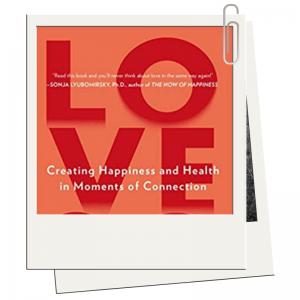 This is a book review of Love 2.0 by Barbara Frederickson, PhD. The book focuses on shifting our perception of love from the archaic view that love is eternal and marked by long term devotion and commitment. To a new view, based on scientific findings that;
This is a book review of Love 2.0 by Barbara Frederickson, PhD. The book focuses on shifting our perception of love from the archaic view that love is eternal and marked by long term devotion and commitment. To a new view, based on scientific findings that;
Love is simply micro moments of connection.
Fredrickson terms these points of connection ‘positivity resonance’ and defines them as a sharing of positive emotions between two people. As with all my book reviews, this is just my interpretation of the book, so if you’re interested, my suggestion is always to grab the book for yourself.
Part 1: The Vision
Love 2.0 highlihgts that Love isn’t simply another emotion, it’s the supreme emotion as it can transform any other emotion, be it joy, surprise, gratitude or hope into a moment of connection with another. Essentially love transforms all other emotions into something greater, that has benefits beyond the self. Love draws us out of our self focus to tune in to others and allows us to see another with care, compassion and concern.
Love is an emotional state that infuses your mind and body with positivity. It is connection between two people and best measured in seconds rather than years. Love can occur when any two people, even strangers share one of the following elements:
1. A shared positive emotion
2. A synchrony between your bodies and biochemistry or
3. Investing in each other’s wellbeing
Love is something that occurs in the space between two people as opposed to within one individual.
There are two prerequisites for love; safety and connection.
Many people spend more time on social media, with their ‘to do’ lists or on technology than building real and lasting connections with the people around them. In the USA, for the first-time, children’s life expectancy has decreased relative to that of their parents. From birth, our bodies are hard wired to seek out love and gain sustenance from it. Moments of love defend you from illness and enable you to grow healthier and survive.
 Whether making love or sharing a laugh with a stranger, both moments of positivity resonance provide connection and tie us to the rich social fabric around us. Our bodies experience these as moments of love and moves toward them. Depression smothers the sparks of positivity resonance and suppresses opportunities for connection and love.
Whether making love or sharing a laugh with a stranger, both moments of positivity resonance provide connection and tie us to the rich social fabric around us. Our bodies experience these as moments of love and moves toward them. Depression smothers the sparks of positivity resonance and suppresses opportunities for connection and love.
Just as plants continually turn toward the sun, so our own bodies constantly shift toward love and respond with each micro moment of positivity resonance.
There are three key elements in how your body responds to love;
1. The brain shifts from ‘me’ to ‘we’ thinking. The presence of mirror neurons enables us to tune into other’s emotions and our brains couple together when we experience moments of rapport or positivity resonance. This synchronises us to become more compassionate, responsive and caring for the other and happens when neural coupling occurs. (P. 45) This coupling happens in the insula, the area of the brain linked with conscious feeling states. Love therefore is a single act shared between two separate brains.
2. Oxytocin is the hormone released in our brains when we connect with others, during birth, breast feeding or are intimate. The release of oxytocin induces feelings of trust and connection. One study indicated professionals were 44% more trusting after being given oxytocin, interestingly, that trust wasn’t indiscriminate. The trust that was developed was a result of heightened sensitivity to interpersonal cues and becoming more tuned in to others led to more accurate assessments of who to trust and who should be avoided. Oxytocin supports you to deal with stress better, reduces your heart rate, blood pressure and feelings of depression, it also increases your pain threshold. Oxytocin calms your body and calls for connection enabling the ‘calm and connect’ response in many situations.
3. The vagus nerve connects the brain to the body, and most importantly, your brain to your heart. The vagus nerve can be measured through tracking your heart rate and breathing rates together, this is called vagal tone and the higher the vagal tone the better. People with high vagal tone are more flexible physically, mentally and socially. They adapt better to changing situations and regulate bodily processes more effectively, like glucose levels and inflammation and also have a stronger immune system. Mentally they regulate their emotions, attention and behaviour better than those with low vagal tone and socially they navigate relationships and interactions with ease, forming more positive connections with others more often. Essentially, those with higher vagal tone experience more micro moments of positivity resonance, in turn leading to higher vagal tone and improved physical, mental and social outcomes. Loving Kindness Meditation (LKM) has been shown to improve vagal tone.
Lack of love compromises your immunity and health diminishing your vagal tone and creating a downward spiral.
 Positive emotions open your brain to creating more micro moments of positivity resonance while negative emotions close you off from the possibility of seeing and engaging in these same opportunities.
Positive emotions open your brain to creating more micro moments of positivity resonance while negative emotions close you off from the possibility of seeing and engaging in these same opportunities.
Love is characterised by four non-verbal cues:
1. Smiling frequency
2. Open and friendly hand gestures
3. Leaning or turning toward each other
4. Head nodding in a sign of agreeance, acceptance or acknowledgement.
Positivity resonance can occur when two people are physically moving together, for example, dancing, kayaking or singing. Couples who do new and exciting things together experience more of this resonance than others.
Resilient people are emotionally agile, they are open to challenges and accept adversity as it appears. They don’t try to numb negative emotions but are able to calibrate their responses quickly, and effectively minimise negative consequences. Positive emotions are key components to building up resilience, as are moments of positivity resonance.
Love, as positivity resonance, expands your awareness, connects you to others and boosts IQ unlocking your core wisdom. A lack of positivity resonance is more damaging to your health than smoking cigarettes, excessive drinking or obesity. People who experience more warm connections to others have fewer colds, lower blood pressure, less incidence of heart disease, stroke, diabetes, Alzheimer’s and some cancers.
Love is good for your health.
Part two: The Guidance
 Your potential for love and moments of positivity resonance are unbounded. The opportunities for social connections, family ties and strong relationships are limitless, each time you encounter another human, this potential rests between you. The key is to activate it. Sincerity is essential for positivity resonance, without it, relationships are damaged.
Your potential for love and moments of positivity resonance are unbounded. The opportunities for social connections, family ties and strong relationships are limitless, each time you encounter another human, this potential rests between you. The key is to activate it. Sincerity is essential for positivity resonance, without it, relationships are damaged.
Activities that facilitate positivity resonance:
1. In the evening, reflect on 3 social connections you’ve experienced throughout your day. Notice who was present with each connection, the strength of the connection and how you could possibly improve or become more open to this connection in the future.
2. LKM opens your mind and heart to those around you and strengthens your ability to connect more readily to others. It also improves vagal tone. EG. May you be well, may you be happy, may you be peaceful, may you be loved.
3. Self compassion is the ability to extend kindness and warmth to yourself. A collaborative LKM may facilitate this. EG. May we be well, may we be happy, may we be peaceful, may we be loved. Traditional LKM begins with the self, however many Western cultures find this confronting and practice this element last.
Just like lifting weights, the number of times you practice positivity resonance (or alternatively negativity) enables the body and brain to build up muscle and support more of the same. Eyes open positivity is full, heart felt openness. It’s warm and genuine and holds well wishes for others. Eyes closed positivity is self-protective, a false display to the world of positivity that has little depth or substance. Much of the self-help movement that promotes positive thinking, to the exclusion of all else, is fostering this mentality and can lead to cold narcissism.
Compassion enables love. Self compassion mantra “May I, together will all others who suffer this, find peace.” Compassion mantra “May you be well, even in the midst of pain, may you be happy, even in the midst of pain, may you be peaceful, even in the midst of pain, may you be loved, even in the midst of pain.”
The average person experiences three positive episodes to every one negative, if we allowed our focus to sit with these positives, we would achieve the recommended positivity ratio of 3:1. The negativity bias however generally shifts our view to focus more on the negatives than the more frequently occurring positives. Prioritising positivity is about consciously tuning in to the positives in your life. “Love is the shortest definition of spirituality I know.” George Vallant
Just as one bout of physical exercise wont change your body shape and one stem of broccoli wont heal your gut, nor will one moment of positivity resonance create cascading positive changes in your life. As Jeremy put it “You can work as hard as you want, but if you are not connecting, you are not going to be successful or happy.”
Love is our supreme emotion, it governs all that we feel, think, do and become. We would do well to cultivate more of it.
Love 2.0 was a really great book and a whole new take on the ancient notion of love. Fredrickson also wrote Positivity, another of my favorite books. Her depth of science is refreshing and the way Fredrickson weaves research into practical examples and advice makes it very readable. If you’re interested in what love is, how it impacts our minds and bodies and how to create more of it, this is a definite must for your reading list.







